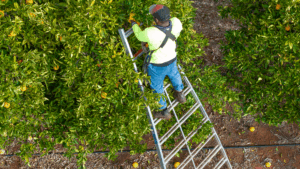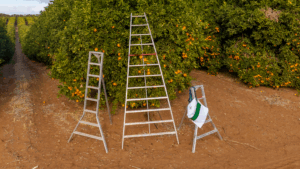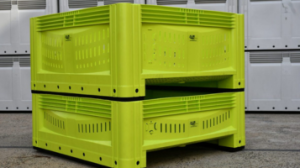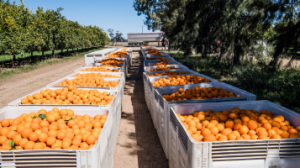Managing orchards efficiently requires the right tools, and orchard ladders are an essential part of the job. From fruit picking to pruning and general tree maintenance, having a safe, reliable ladder can make all the difference. In this guide, we’ll explore the different types of orchard ladders, important features to look for, safety tips, and where Australian growers can find the best options.
What Is an Orchard Ladder, and Why Is It Important?
An orchard ladder is a specialised ladder designed to help workers safely reach fruit in high branches, prune trees, and perform other orchard maintenance tasks. Compared to regular ladders, they offer better stability on uneven terrain and have ground spikes making them ideal for orchards and farms. A well-chosen orchard ladder improves efficiency and reduces strain on workers, ensuring smoother operations during fruit picking seasons.
Tripod Orchard Ladders
Tripod ladders are a three-legged structure, with the third leg providing stability on uneven ground. They are used for trees with weak or sparse branches that cannot support a bow ladder. They’re most commonly used on mounded rows and mandarin trees as the 3 legs is best suited for with uneven or sloping terrain.
Platform Ladders
Stools (one or two step) and platform ladders are commonly used on small to medium sized trees. they have a wide platform at the top for added reach and comfort during longer tasks such as pruning. However they’re heavier and less portable than tripod ladders. also, the 4 leg design makes them unstable on uneven or sloped ground.
Bow Ladders (Citrus Picking Ladders)
Bow ladders feature a distinct curved shape that provides extra support and access to the fruit. they are most commonly used on mature orange trees. the ladders require strong or dense branches to support the weight of the picker.
Key Considerations When Choosing an Orchard Ladder
When selecting the best orchard ladder for your needs, consider the following factors:
Safety Features
Choose ladders with ground spikes built to last. Every AIM ladder has a stainless steel spike with a rounded end. The rounded tip deflects off irrigation lines to prevent punctures, while the stainless steel resists dirt abrasion and wear even after thousands of uses.
It’s also important that the ladder has a clearly marked rung indicating the highest safe standing point, so users aren’t tempted to overreach. In addition, look for non-slip rungs designed to provide secure footing, even in muddy or damp orchard conditions.
Material and Durability
Aluminium ladders are lightweight, weather-resistant, and long-lasting, making them ideal for Australian conditions. when looking for a picking ladder, go for a design with the fewest welds. Each weld in aluminium creates a potential weak point. Most importantly, make sure the ladder is of a quality that you would trust with your life — a failure at height can be fatal.
Portability and Ease of Use
For large orchards, choose a ladder that is lightweight and easy to stack. This makes moving multiple ladders around the orchard or between farms much simpler.
How to Choose the Right Height
When deciding what height ladder to get, a good guide is that a worker can safely reach around 2 metres above where they stand. This means for trees around 2–3 m tall, a 6 ft (1.8 m) ladder is usually enough. Trees in the 3–4 m range suit an 8–10 ft (2.4–3 m) ladder, while taller trees of 4–5 m or more may require a 12–14 ft (3.6–4.2 m) ladder.
Remember that the pickers hips should never go higher than the top rung of the ladder.
Orchard Ladder Safety Tips
To learn how to safely pick fruit with an orchard ladder check out our other articles.
The Benefits of Using Orchard Ladders
Investing in a quality ladder for tree maintenance offers many advantages, including:
Increased Efficiency: Workers can quickly and safely reach high branches, speeding up fruit picking and pruning.
Reduced Physical Strain: Well-designed ladders reduce fatigue by providing stable platforms, improving worker comfort.
Enhanced Safety: Ladders with anti-slip features and stable designs minimise the risk of falls and injuries.
Long-term Productivity: Durable ladders require less maintenance, ensuring reliable performance for years to come
Choosing the right orchard ladder is crucial for efficient, safe, and comfortable orchard work. Whether you need a tripod ladder for sloping terrain, a platform ladder for pruning, or a lightweight aluminium ladder for all-weather use, it’s essential to select a ladder that suits your orchard’s specific needs. Prioritising safety, durability, and ease of use will help you get the most out of your investment.
Equip yourself with the right ladder, and you’ll be well-prepared for fruit picking, pruning, and tree maintenance—boosting both productivity and safety throughout the growing season..




